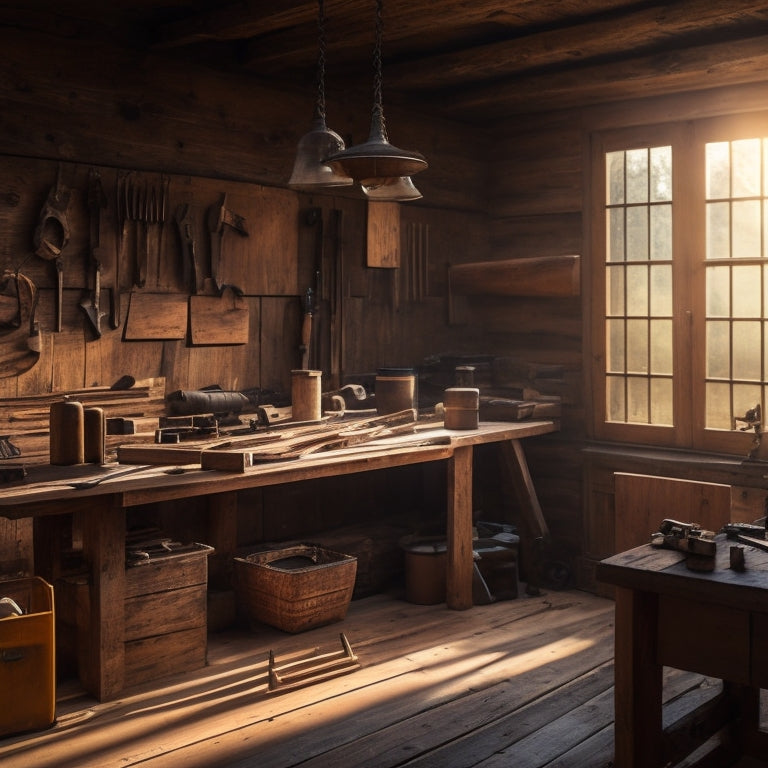
Woodworking Wonders: Simple Projects and Plans
Share
Begin a woodworking journey with simple, yet rewarding projects that build foundational skills and foster creativity. Start with essential projects like birdhouses, wooden coasters, and bookshelves to develop fundamental skills and confidence. Mastering woodworking fundamentals, such as tool understanding, joint techniques, and wood identification, is essential for success. As skills improve, creativity can shine through, transforming wood into stunning pieces of art that evoke emotions and spark imagination. By exploring these simple projects and plans, you'll discover the vital steps to unleash your full woodworking potential and create true woodworking wonders.
Key Takeaways
• Start with simple projects like birdhouses and wooden coasters to develop fundamental skills and confidence in woodworking.
• Master woodworking fundamentals like tool understanding, joint techniques, and wood identification to enhance skills.
• Build a birdhouse, create wooden coasters, and make a simple bookshelf to develop measuring, cutting, and assembling techniques.
• Explore plans that unleash woodworking potential and prioritize safety precautions for a successful woodworking experience.
• Avoid beginner mistakes like skipping sanding and gain confidence in woodworking abilities through practice and patience.
Essential Woodworking Projects
For beginners, it is essential to start with woodworking projects that are both fun and easy to complete. Examples include building a birdhouse, creating wooden coasters, or making a simple bookshelf. These projects allow novices to develop fundamental skills while building confidence in their abilities.
Birdhouse construction teaches essential techniques like measuring, cutting, and assembling, while also introducing beginners to birdhouse design principles. Wooden coaster designs enable woodworkers to experiment with different wood types, shapes, and finishes.
Mastering Woodworking Fundamentals
As beginners gain confidence in their abilities through initial projects, they can now focus on mastering the fundamental skills and techniques that underpin successful woodworking. This includes understanding various tools, joints, and wood types. Acquiring woodworking techniques is crucial to avoid common beginner mistakes, such as not measuring twice or skipping sanding.
Additionally, safety precautions should always be top of mind. This includes wearing safety glasses and ear protection, and keeping the work area clean. By honing these fundamentals, woodworkers can access the many benefits of woodworking, including stress relief, boosts in creativity, and a sense of accomplishment.
With a solid foundation in place, woodworkers can then explore more complex projects and techniques, leading to a lifelong passion for this rewarding hobby.
Transforming Wood Into Art
Beyond the functional aspects of woodworking, lies the domain of artistic expression, where wood is transformed into stunning pieces that showcase craftsmanship, creativity, and attention to detail. This is where woodworking artistry comes alive, as skilled craftspeople push the boundaries of what is possible with wood.
Through creative craftsmanship, they coax out intricate patterns, shapes, and forms that evoke emotions and spark imagination. Whether it's a beautifully carved wooden sculpture or an intricately inlaid wooden panel, the art of woodworking is a testament to human ingenuity and creativity.
Frequently Asked Questions
Can I Use Reclaimed Wood for Outdoor Woodworking Projects?
When using reclaimed wood for outdoor projects, consider the wood grain's natural weather resistance and potential for warping. Inspect the wood for signs of decay, and apply a weather-resistant finish to guarantee durability and longevity.
How Do I Prevent Warping in Woodworking Projects?
As wood fibers align like soldiers in formation, warping can be prevented by mastering moisture management and wood stabilization techniques, ensuring a harmonious balance of humidity and tension to yield a sturdy, straight project.
What's the Best Way to Store Unfinished Woodworking Projects?
To store unfinished woodworking projects, prioritize dust protection by covering them with breathable cloth or plastic sheets, and optimize your workspace by designating a specific area for storage, ensuring easy access and minimizing clutter.
Can I Use a Hand Saw Instead of a Power Saw for Small Projects?
For small projects, a hand saw can be a viable alternative to a power saw, offering more control and precision. Mastering hand saw techniques, such as proper grip and stroke, and maintaining a sharp saw blade through regular maintenance, guarantees accurate cuts and minimizes fatigue.
How Do I Properly Dispose of Woodworking Waste and Scraps?
"As we craft our masterpieces, let us not forget the residue of our creativity - the waste. Segregate your scraps thoughtfully, considering the environmental impact, and dispose of them responsibly, recycling whenever possible, to minimize the ecological footprint of your woodworking endeavors."
Conclusion
To sum up, woodworking offers a world of creative possibilities, and with persistence and patience, anyone can master this craft.
As the adage goes, 'Rome wasn't built in a day,' and neither is a woodworking masterpiece. By starting with essential projects and mastering fundamental techniques, individuals can tap into the full potential of woodworking.
With this guide, beginners can transform wood into functional and beautiful pieces, discovering the joy and satisfaction that comes with creating something with one's own hands.
Related Posts
-

Sports Equipment Organization for the Garage
Sports Equipment Organization for the Garage: A Comprehensive Guide As an avid sports enthusiast, I know firsthand...
-

Why Wasted Space in Your Compact Cooking Area?
You've likely invested time and money into creating a functional kitchen, but wasted space in your compact cooking ar...

